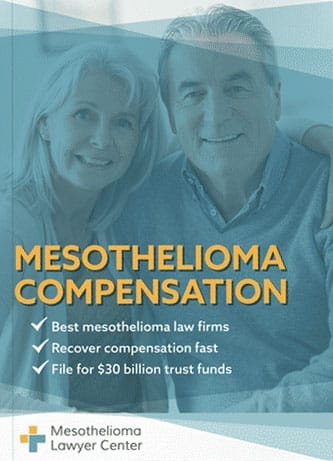If you’ve been injured by asbestos, an experienced Charlotte mesothelioma lawyer may be able to assist you. Many job sites in Charlotte once relied heavily on asbestos. This resulted in worker exposure and resulting illnesses.
If you or a loved one have mesothelioma, asbestos-related lung cancer, or asbestosis, you may be eligible for a large amount of compensation. Fill out our form to get a free Financial Compensation Packet. You’ll learn about the experienced mesothelioma lawyers in Charlotte, how to get paid in 90 days, how to file a claim for the asbestos trust funds, and more.


FREE Financial Compensation Packet
- Info on law firms that will recover your HIGHEST COMPENSATION
- Learn how to get paid in 90 days
- File for your share of $30 billion in trust funds
Charlotte Asbestos Facts
- Charlotte and Mecklenburg County have the second-highest highest number of asbestos-related deaths in the state.
- The death rate in the county between 1999 and 2017 was 386.
- Several industries in the Charlotte area contributed to asbestos exposure, including paper mills, textile mills, and construction materials.
About Mesothelioma and Asbestos
Mesothelioma is a rare cancer caused by asbestos exposure. The most common form is pleural mesothelioma which results from inhaling asbestos fibers. Symptoms of pleural mesothelioma include coughing, chest pains, and difficulty breathing.
Peritoneal mesothelioma affects the abdomen and causes symptoms like bloating, abdominal pain, and gastrointestinal issues such as diarrhea and constipation.
Although rare, about 3,000 people are diagnosed with mesothelioma every year, some in Charlotte, North Carolina. The majority of these people were negligently exposed to asbestos at work.
Yes, asbestos can still be found in certain items today, especially those manufactured before 1981. Despite federal regulations limiting its use in new products, this hazardous material persists in older goods. Here are some of the items where asbestos might still be present:
- Vinyl Roof Tiles: Often found in older buildings, these tiles were prized for their durability and heat resistance.
- Heat-Resistant Textiles: Used in protective clothing and industrial environments.
- Industrial Pipe Insulation: Common in factories and facilities where temperature control is essential.
- Roofing and Siding Shingles: Especially in structures built before the ban.
- Automobile Parts: Brake linings and clutch pads in vehicles manufactured decades ago.
- Ceiling Tiles and Spray-On Coatings: Widely used during construction booms in the mid-20th century.
- Building Materials: Such as plaster, cement, putties, and caulk used in older constructions.
These items pose a significant threat to both workers in various industries and the general public, as exposure can lead to serious health issues.
How Long Does It Take for Mesothelioma Symptoms to Appear?
Mesothelioma, a rare and aggressive cancer often linked to asbestos exposure, presents a unique challenge due to its lengthy latency period. Symptoms can take decades to emerge—typically between 20 and 50 years after initial exposure. This extended delay makes early detection exceedingly difficult, frequently leading to a diagnosis at an advanced stage.
Why the Delay?
- Asbestos Exposure: The primary culprit in mesothelioma cases is asbestos, a group of minerals with microscopic fibers. Once inhaled or ingested, these fibers can become lodged in the lining of the lungs, abdomen, or heart.
- Cellular Changes: Over time, these fibers cause inflammation and cellular changes that may eventually result in cancer. However, these changes occur gradually, contributing to the long latency period.
Key Takeaways
- Extended Monitoring: Because of the delayed onset of symptoms, even those exposed to asbestos long ago should remain vigilant for potential signs of mesothelioma.
- Regular Check-Ups: Monitoring through regular health check-ups and informing healthcare providers of past asbestos exposure can improve early detection odds.
Understanding the typical latency of mesothelioma symptoms underscores the importance of ongoing health evaluations for those with a history of asbestos exposure, even decades later.
Regulations aimed at limiting the use of asbestos in the United States began to take shape during the 1970s. This period marked a pivotal shift as federal laws and guidelines were introduced to control and reduce the prevalence of asbestos-containing materials. Despite these efforts, asbestos exposure continues to be a concern.
Why is Mesothelioma Difficult to Diagnose?
Mesothelioma presents a significant diagnostic challenge primarily due to its symptoms. Often, the signs mimic those of more common and less severe respiratory illnesses, causing confusion among both patients and healthcare providers.
Commonly Overlooked Symptoms
Many early symptoms of mesothelioma, such as persistent cough, chest pain, and shortness of breath, are easily mistaken for conditions like bronchitis or pneumonia. This similarity often leads to misdiagnoses or delays in identifying the cause.
Long Latency Period
Another factor complicating diagnosis is the long latency period. Mesothelioma can take 20 to 50 years to develop after initial exposure to asbestos, the primary risk factor. Such a lengthy gap between exposure and manifestation makes it challenging to connect symptoms to their root cause.
Limited Awareness and Experience
Moreover, mesothelioma is a rare disease, which means doctors may not encounter it frequently in practice. As a result, there’s often limited awareness and experience in identifying the disease early.
Key Diagnostic Tests
To accurately diagnose mesothelioma, specific tests are required, such as imaging scans or biopsies. Unfortunately, these tests are typically only conducted after more common illnesses have been ruled out.
Understanding these complexities highlights why mesothelioma diagnosis can be delayed, underscoring the importance of specialized medical attention when symptoms persist.
Exploring Treatment Options for Mesothelioma
If you’re wondering whether there’s a cure for mesothelioma, it’s important to understand the realities of this challenging condition. Currently, there is no definitive cure for mesothelioma, a form of cancer often linked to asbestos exposure.
What Are the Current Options?
- Medical Treatments:
- Surgery: In some cases, surgical intervention is used to remove cancerous tissues. This can help alleviate symptoms and slow the spread of the disease.
- Chemotherapy and Radiation: These treatments aim to control the growth of mesothelioma cells, providing relief and potentially extending life expectancy.
- Clinical Trials:
- Patients may consider participating in clinical trials, which investigate new therapies and combinations of treatments. These offer hope by testing innovative approaches that aren’t yet widely available.
- Palliative Care:
- While it doesn’t cure the disease, palliative care focuses on managing symptoms and improving quality of life. This holistic approach addresses physical discomfort and emotional well-being.
Moving Forward
Although a cure remains elusive, advancements continue in the realm of oncology. Researchers and medical professionals are working tirelessly to develop new therapies that may one day lead to a breakthrough.
In summary, while mesothelioma currently lacks a cure, treatment options exist to manage the disease and support patients in living more comfortably. Always consult with healthcare providers to explore the best individual strategy.
What Steps to Take If You Suspect Mesothelioma After Asbestos Exposure
If you’ve been exposed to asbestos and begin noticing signs that might indicate mesothelioma, it’s crucial to act swiftly and effectively. Here’s a step-by-step guide on what you should do:
- Monitor Your Health Closely
Keep an eye out for common mesothelioma symptoms such as persistent cough, chest pain, or shortness of breath. Other signs might include unexplained weight loss and swelling in the abdomen. - Consult a Healthcare Professional
Schedule an appointment with a doctor as soon as possible. Be sure to discuss your history of asbestos exposure in detail. This information is vital for accurate diagnosis and prompt treatment. - Pursue Advanced Diagnostic Testing
Request specific tests to confirm the presence of mesothelioma. These may include imaging tests like X-rays or CT scans and biopsies for tissue analysis. - Seek Specialist Care
Reach out to a specialist in oncology who has experience with mesothelioma. They can offer tailored treatment options and the latest advancements in care. - Educate Yourself on Treatment Options
Learn about the potential treatments available such as surgery, chemotherapy, or radiation therapy, to ensure informed decisions about your health care. - Connect with Support Networks
Don’t navigate this journey alone; reach out to support groups for mesothelioma patients and families. These networks provide emotional support and practical advice from those who’ve experienced similar challenges.
Taking these steps not only empowers you but also greatly improves the chances of receiving the proper care necessary for combating this serious condition.
How Charlotte Mesothelioma Lawyers Can Help

If you have a diagnosis of mesothelioma, contact a top North Carolina mesothelioma lawyer working in Charlotte. Get in touch as soon as possible to ensure you have a fair chance to recover damages.
Charlotte mesothelioma and asbestos lawyers can help you by explaining your legal options and helping you decide the best step to take to get compensation.
Make sure the lawyer you choose is an expert in asbestos cases and has proven experience winning compensation for similar clients. They should be backed by a large firm with adequate resources to investigate and build your case and take it to a successful conclusion.
You might not know where you encountered asbestos in the past. A Charlotte asbestos law firm can examine your work history and determine where and when you were exposed. They will find the companies responsible and help you hold them liable for your resulting expenses.
To succeed in a mesothelioma claim, it must be proven without a doubt that the at-fault party was responsible for causing the diagnosis. This requires more than just identifying the exposure site. Profound medical knowledge and connections within the Charlotte medical community are crucial.
By leveraging these resources, your legal team can gather compelling evidence to establish a direct link between exposure and your condition. This comprehensive approach ensures that all aspects of responsibility are addressed, bolstering your case for compensation.
When it comes to our legal services for mesothelioma claims, our policy is straightforward and client-focused. You won’t incur any legal fees unless we successfully secure compensation or achieve a favorable verdict for your case. This means you can pursue justice and financial relief without the stress of upfront costs or financial risk. Your peace of mind is our priority, ensuring that our interests are aligned in working diligently to secure the best possible outcome for you.
How Can an Attorney Help Connect You with Medical Professionals for Mesothelioma Treatment?
When facing a diagnosis like mesothelioma, finding the right medical treatment is crucial. An experienced attorney can be a vital resource in this journey for several reasons:
- Network of Medical Experts: Attorneys specializing in mesothelioma cases often have an extensive network of medical professionals. They can refer you to top oncologists, specialists, and treatment centers that focus on asbestos-related illnesses such as the Mayo Clinic or Cleveland Clinic.
- Coordinating Care: Legal professionals can assist in coordinating your medical care by liaising with healthcare providers. They ensure that the necessary treatments are aligned with your legal case, thus streamlining your path to both health and justice.
- Access to Resources: Attorneys have access to a wealth of resources, including databases of medical experts and treatment advancements. This information can be crucial in finding innovative treatments and clinical trials that may benefit your specific condition.
- Assistance with Medical Expenses: Through successful litigation or settlements, attorneys can help secure compensation to cover the costs of medical treatments, ensuring financial constraints do not hinder your access to necessary care.
By leveraging their expertise and connections, attorneys can make a significant difference in not only your legal battle but also in aligning you with the right medical care.
Where Was I Exposed to Asbestos in Charlotte, North Carolina?
Many Charlotte worksites exposed workers to asbestos in the past. These are just a few examples. Other sources of exposure include older buildings, like schools, homes, and government buildings.
Carolina Asbestos Company
Nearby Davidson was once home to a company that manufactured asbestos fabrics, shingles, and tiles, known as the Carolina Asbestos Company. The property is known today as the Davidson Depot.
The lingering asbestos on the site is a health issue, but the problem extends beyond the old mill for nearby residents. Materials from the site were used as fill material in the surrounding area. Many homes now sit on top of asbestos.
A cap was put on asbestos in the ground, but it leaked in 2017. The Environmental Protection Agency (EPA) stepped in to clean up, removing thousands of tons from the soil. They did not test all properties, and residents are concerned that asbestos lingers in their soil. As of 2021, EPA clean-up projects continue at the site.
Gold Bond/National Gypsum

Established in 1925, the National Gypsum Company is a leading manufacturer of construction and building products headquartered in Charlotte.
Like most manufacturing companies before EPA asbestos regulations, the National Gypsum Company used asbestos in many products for decades.
Most of the products made with asbestos were made under the Gold Bond Buildings Products label, including:
- Plasters
- Siding
- Cement board
- Panels
- Permaboard
- Humidity-proof panels
- Joint compounds
- Texture paint
Lawsuits soon followed against both National Gypsum Company and Gold Bond Building Products.
The sheer amount of lawsuits resulted in the 1985 Wellington Agreement, in which the company moved all of its pending asbestos lawsuits to the Asbestos Claims Facility. In 1990, National Gypsum filed for Chapter 11 bankruptcy.
In 1993, the company, now called NGC, created an asbestos trust fund and settlement deal to prevent future asbestos lawsuits. The company was also required to pay $347 million to the Asbestos Claims Management Corporation (ACMC).
Southern Asbestos Company Mills
The Southern Asbestos Company Mills operated in the Greenville neighborhood of Charlotte. It opened in 1904 as a cotton mill. Beginning in 1920, it manufactured asbestos textiles.
Workers in the facility risked asbestos exposure, as did nearby residents. People who lived near the mills remember the waste that contaminated the air and their homes. They recount playing in waste dumps from the mills.
Additional Job Sites Associated with Asbestos Use in Charlotte
Charlotte’s past as a mining and industrial town has left harmful asbestos in many locations.
Schools and Hospitals
- Coulwood Middle School
- Johnson C Smith University
- University of North Carolina
- Western North Carolina Vocational School
- Charlotte Memorial Hospital
- Novant Health Presbyterian Medical Center
- CMC Mercy Hospital
- Davidson College
- Hawthorne Medical Center
Manufacturing
- Barnhardt Manufacturing Company
- Highland Park Manufacturing Company
- Savona Manufacturing
Mills
- Anchor Mills
- Arlington Cotton Mills
- Chadbourn Hosiery Mills, Inc.
- Charlotte Cotton Mills
- Highland Mills
Plants
- Charlotte Ordnance Missile Plant (COMP)
- Westinghouse Plant
Additional Job Sites, Buildings, and Businesses
- Acoustics Engineering
- Charlotte Douglas International Airport
- WSOC TV
- WBTV
- Charlottetown Mall
- Charlotte Utilities
- D. & B. Insulation Company, Inc.
- Duke Energy
- J.A. Jones Construction Company
- The Linde Group
- McLaren Industries
- North Carolina National Bank
- The Porter Hayden Company
- Robinson Electric Company
- Radisson Hotel
- Wachovia Bank
- Webel Knitting Company
What Regulations Exist to Protect Employees from Asbestos Exposure?
To safeguard employees from asbestos exposure, several regulatory measures have been put in place by key organizations.
Key Regulations and Standards
- Occupational Health and Safety Act (OSHA Standards):
- The Occupational Safety and Health Administration (OSHA) has developed strict guidelines that employers must follow to minimize asbestos exposure.
- These standards mandate the use of protective equipment and proper safety protocols in workplaces containing asbestos.
- Exposure Limits:
- OSHA outlines permissible exposure limits (PELs) for asbestos, ensuring that occupational exposure does not exceed specific levels.
- Regular monitoring and assessments are required to maintain air quality within these limits.
- Worker Training and Education:
- Employers are required to provide comprehensive training to employees about asbestos risks, safe handling practices, and emergency procedures.
- Workers must be informed of potential hazards and how to effectively utilize protective gear.
- Medical Surveillance:
- Regular health screenings are mandated for workers who are exposed to higher levels of asbestos over prolonged periods.
- This ensures early detection of any health issues and proactive management.
Compliance and Enforcement
Organizations that fail to adhere to these regulations face penalties and sanctions. These measures collectively aim to create safer work environments by reducing the risks associated with asbestos, thus prioritizing the health and safety of employees.
In North Carolina, construction managers and developers bear significant responsibilities when it comes to managing asbestos risks. These professionals must adhere to comprehensive regulations and codes specifically designed to safeguard both construction workers and the public from potential asbestos exposure.
Key Responsibilities:
- Regulation Compliance:
- Construction managers and developers are required to strictly follow state and federal guidelines. This includes adherence to the Occupational Safety and Health Administration (OSHA) standards.
- Risk Assessment:
- Conduct thorough assessments of sites before construction begins. Identifying any materials that may contain asbestos is crucial to ensure proper management and removal.
- Safe Removal Practices:
- When asbestos is detected, it must be safely removed by licensed professionals to minimize potential health risks. Project managers must ensure this process complies with Environmental Protection Agency (EPA) directives.
- Worker Safety:
- It is imperative for managers to provide adequate training to their crews. Awareness and education on handling asbestos-containing materials are essential components of workplace safety.
- Public Safety Measures:
- Develop clear communication strategies to inform the public about any potential asbestos-related activities. This transparency helps maintain community trust and ensures adherence to health and safety regulations.
By fulfilling these responsibilities, construction managers and developers can effectively prevent asbestos exposure and safeguard public health.
Mesothelioma Treatment Near Charlotte, North Carolina

For victims of asbestos diseases, there are three major cancer facilities in North Carolina. These cancer centers and staff offer specialized medical treatment, counseling, clinical trials, and other services.
- Duke Cancer Institute, Duke University Medical Center, Durham
- Wake Forest Baptist Comprehensive Cancer Center, Winston-Salem
- Lineberger Comprehensive Cancer Center, University of North Carolina, Chapel Hill
When my husband was diagnosed we had no idea what to do. Our doctor said we should reach out to an attorney to talk about compensation. After talking to several firms we found the mesothelioma lawyer center and were grateful we did. They helped with every step of the way. If you need a meso attorney then I would recommend contacting them
– Isabelle D.
Legal Help in Charlotte and Additional Information
Get our free Financial Compensation Packet for information on the top mesothelioma and asbestos lawyers in your area. If you have questions or need assistance, contact us toll-free at 800-793-4540.

Paul Danziger
Reviewer and EditorPaul Danziger grew up in Houston, Texas and earned a law degree from Northwestern University School of Law in Chicago. For over 25 years years he has focused on representing mesothelioma cancer victims and others hurt by asbestos exposure. Paul and his law firm have represented thousands of people diagnosed with mesothelioma, asbestosis, and lung cancer, recovering significant compensation for injured clients. Every client is extremely important to Paul and he will take every call from clients who want to speak with him. Paul and his law firm handle mesothelioma cases throughout the United States.
Connect with North Carolina Mesothelioma Lawyer Paul Danziger
References
- United States Court of Appeals for the Fifth Circuit. (2000, March 31). National Gypsum Company v. National Gypsum Company Settlement Trust.
Retrieved from: https://law.resource.org/pub/us/case/reporter/F3/208/208.F3d.498.98-11116.html - Environmental Working Group. (n.d.). Asbestos-Related Deaths in North Carolina.
Retrieved from: http://www.asbestosnation.org/facts/asbestos-deaths/nc/ - Boraks, D. (2020, January 16). State Proposes ‘Asbestos Watch Area’ Near Old Davidson Mill. WFAE.
Retrieved from: https://www.wfae.org/post/state-proposes-asbestos-watch-area-near-old-davidson-mill#stream/0 - Boraks, D. (2021, January 28). EPA To Remove Asbestos At 11 More Davidson Sites, Including Park. WFAE.
Retrieved from: https://www.wfae.org/energy-environment/2021-01-28/epa-to-remove-asbestos-at-11-more-davidson-sites-including-park - University of North Carolina Charlotte. J. Murrey Atkins Library. (2022, December 16). Historic Charlotte Neighborhoods. History of Greenville.
Retrieved from: https://guides.library.charlotte.edu/c.php?g=621704&p=5192974 - National Cancer Institute. (n.d.). Find a Cancer Center. North Carolina.
Retrieved from: https://www.cancer.gov/research/infrastructure/cancer-centers/find#NorthCarolina
